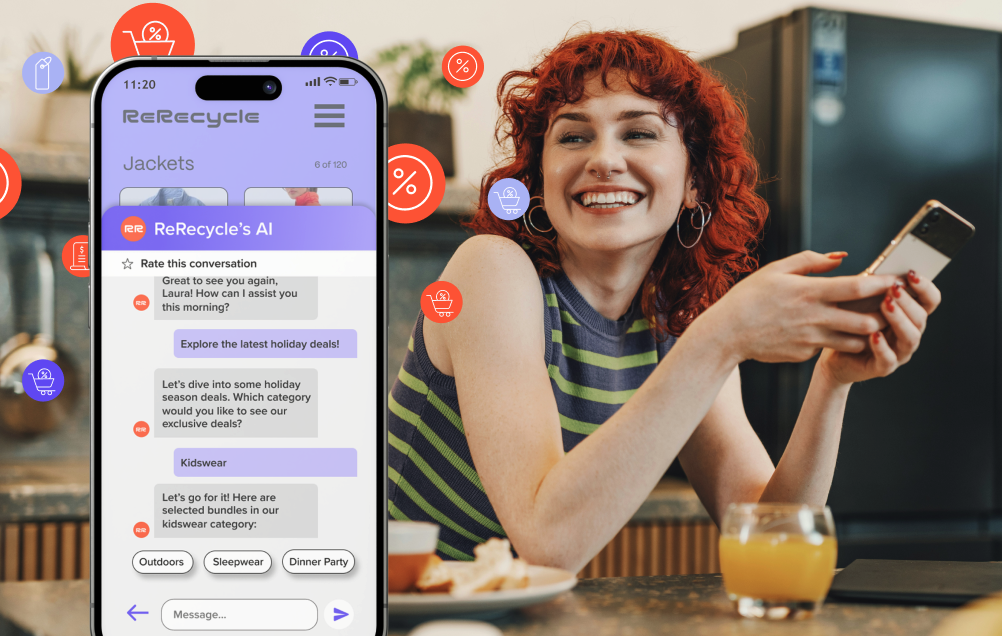The In-Person Shopping Experience is Making a Comeback: Here’s How to Adapt
The last two years have turned the retail world upside down.
Relentless lockdowns and stay-at-home orders forced consumers to shop online, and, for a while, it looked like that would be the new norm.
Brands scrambled to cement their online presence and accelerate their digital transformation as it seemed to be the only way to survive–especially when brick-and-mortar shops had to close under government orders.
But now that things are starting to get back to normal, consumers are chomping at the bit to get back in store. The fashion and electronic verticals are particularly in-store focused, with 53% and 46% of shoppers respectively choosing to shop in-store for these products.
Perhaps most surprisingly, a large chunk of Gen Z shoppers (81%) like to discover, trial, and purchase new products in-store.
Despite this, e-commerce is still a growing industry. The convenience of shopping from the comfort of own home, plus the opportunity to check out stores in different parts of the world, is too tempting to discard altogether. Instead, customers are looking for a hybrid approach that combines the convenience of shopping online with the human touch of a brick-and-mortar store.
It’s a win-win for brands as well. Big-name brands that have joined the online world over the past decade have driven up the cost of ads and customer acquisition (CAC). Where low CAC and relatively affordable social media ads used to be a viable model for emerging brands, they can often be out of budget now, leading stores to find other ways to reach shoppers.
Shoppers want in-store experiences with a difference
Perhaps the most significant indicator of the shift to offline is the surge in digitally native brands opening up physical stores.
For example, direct-to-consumer (DTC) glasses retailer Warby Parker was inherently online to begin with, but has since opened more than 35 stores to allow customers to shop in person. In a similar vein, Allbirds, Bonobos, and Glossier now have physical shops.
It’s important to note that these physical stores are an extension of the online experience rather than separate entities completely.
The need for an omnichannel experience has never been greater since consumers use a variety of different devices in their daily lives. When you walk into an Allbirds store or a Bonobos branch, it’s clear that the emphasis is on engagement rather than sales.
Stores like Beardbrand are evolving into content studios where the in-store experience doubles up as a chance to make YouTube videos, while beauty brand Sephora has created the “Sephora Experience” in-store that allows customers to use built-in devices to virtually try on products before they buy.

Sephora’s in-store virtual artists
Sure, customers are choosing to shop in-store, but their expectations have changed. It’s no longer enough to stack shelves with your products and leave it at that; customers expect just as an engaging and personalized experience offline as they do online.
Bringing the in-store experience online: what’s the solution?
Despite consumers making tracks back to in-store shopping, online retail is nowhere near dead. Ecommerce sales are expected to rise to 7.3 billion in 2025, up from 5.5 billion this year, and it’s forecasted to reach 24.5% of total global retail sales in the next three years.
The brands that will see the most success will be those that can provide a seamless offline to online experience or those that incorporate in-store strategies to their online sites.
What does this look like in action?
Omnichannel experiences that span online and offline channels
Shoppers might discover a product through a social media ad on their phone, add it to their cart, receive an abandoned cart email to their desktop, and then eventually purchase it in-store.
There are so many different journeys shoppers can take on a variety of different devices–both online and offline. To keep up with demand, brands need to make switching between channels completely seamless.
For example, when a shopper comes to pick up a product in-store, you might greet them with a screen they can log into which welcomes them by name and highlights other relevant products they might be interested in.
On the flip side, you might take customer information from in-store and use it to send segmented emails based on product interests and previous purchasing history.
Burberry has opened its first social retail store where customers are encouraged to take part in a personalized program in WeChat to find their way around the shop and upload their own content in exchange for virtual currency. This takes the in-store experience away from simply browsing a selection of bags and gamifies it to keep customers engaged and loyal.
Online sales representatives that recreate the in-person experience
A seamless online-offline shopping experience works both ways. As well as incorporating online elements into physical stores, brands can also inject in-person strategies into their online shops.
One of the most common explanations for shopping offline post-pandemic is to regain a human touch. Consumers were deprived of in-person connections for a long time and they’re now craving those experiences in every part of their lives.
There’s no comparison between walking into a physical store and being greeted by a real person who asks you what you need help with and personalizes the shopping experience exactly for your needs. However, online sales representatives can replicate this part of offline shopping.

For example, jewelry brand Pavoi uses Rep’s AI-powered sales assistant to check in with shoppers at high-impact moments.
The automated assistant asks questions and provides responses based on each customer’s unique needs. It gives the brand insights into why some products are selling, while also creating a personalized experience for each shopper depending on where they are in the buying cycle. As a result, sales grew by 11%.

Apparel brand Underoutfit does something similar with a Rep’s AI-powered sales associate.
Customers can get automated help finding their size and tackle objections that might crop up before they buy. Giving shoppers the chance to create their own experiences and get the help they would get from an in-store sales associate has increased the brand’s conversion rate by 315%.
What the shift to in-person shopping means for e-commerce brands
It might be disappointing to see e-commerce sales tailing off, but there is still huge potential in this area. One of the main reasons shoppers are choosing to venture back in-store is because they miss interacting with people and getting a personalized experience from in-store retail sales associates.
The technology available today makes it easier than ever to replicate this in an online capacity.
As well as ensuring a seamless connection between online and offline shopping experiences, brands can bring the in-person sales associates’ experience online with an automated assistant. It can help customers find products they’re looking for, track their orders, find relevant content, and learn more about a brand in just a few clicks.
This keeps engagement levels high and reduces friction in the online shopping process, leading to more conversions, more sales, and ultimately more loyal customers.
Want to learn more about how to improve your customer experience? Book a consultation call with us.
Quick Answers and FAQs
What role do loyalty programs and personalized recommendations play in building brand loyalty in physical stores?
Loyalty programs and personalized recommendations are powerful tools for physical retailers in today's hybrid shopping landscape. As consumers return to in-store shopping with higher expectations, these strategies create the personalized experiences shoppers crave while driving repeat business and fostering emotional connections that transform casual browsers into loyal brand advocates.
Loyalty and Personalization: The Hybrid Retail Advantage
Shoppers are back in stores—but they’ve changed. Expectations are higher. They want more than products; they want experiences that feel personal and rewarding. Retailers who deliver that are winning.
Loyalty programs and personalized recommendations aren’t just nice to have. They build emotional connections that turn browsers into brand advocates—and drive repeat business along the way.
Data-Driven Personalization Starts Here
Imagine greeting every customer like an old friend. Unified customer profiles—pulled from both online and offline data—make it possible.
Tailored recommendations based on purchase history and browsing habits create a sense of familiarity. Loyalty insights take it further, enabling VIP treatment that keeps high-value customers coming back.
It’s not about collecting data. It’s about using it in ways that feel human.
Tiered Loyalty Programs Keep Customers Coming Back
A one-size-fits-all program? That’s not enough.
Tiered memberships reward loyalty by offering real value at every level. Think exclusive events, early product access, and special in-store perks. The more customers engage, the more they gain.
And the more they gain? The more they return.
Omnichannel, Without the Friction
Your customers move between digital and physical spaces. They expect you to keep up.
Connected experiences—where loyalty points, offers, and preferences follow them—are the new standard. Whether they’re browsing on mobile or walking into a store, they want consistency.
How can augmented reality enhance the in-store shopping experience for customers?
Augmented reality (AR) enhances in-store shopping by making it more interactive, personalized, and convenient. Customers can try products virtually, access detailed information instantly, and navigate stores more easily—all through AR-enabled tools.
Key Benefits for Customers
- Virtual Try-Ons: Shoppers can see how clothing, eyewear, or makeup looks on them without using fitting rooms or testers.
- Interactive Product Information: AR displays provide instant access to product details, reviews, and demonstrations—helping customers make informed decisions.
- Simplified Navigation: AR wayfinding apps guide shoppers to products quickly, creating a smoother store experience.
- Personalized Recommendations: Customers receive tailored offers and product suggestions based on their preferences and shopping history.
By combining the convenience of online shopping with the engagement of physical retail, AR helps customers feel more confident and connected during their in-store experience.


.png)










